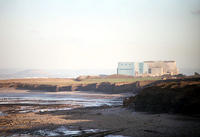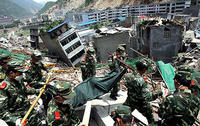-
Exploring asteroids for commercial metal harvesting

Deep Space says that in a decade, it will be harvesting asteroids for metals and other building materials, to construct large communications platforms to replace communications satellites, and later solar power stations to beam carbon-free energy to consumers on Earth. “More than 900 new asteroids that pass near Earth are discovered every year. They can be like the Iron Range of Minnesota was for the Detroit car industry last century,” says the company’s CEO.
-
-
Revealing full-body scanners to be removed from airports
One of the more controversial post-9/11 security devices, the ubiquitous and uncomfortably intrusive full-body scanners, will be removed from service by the Transportation Security Administration (TSA). On Friday, the agency announced it would begin to remove the scanners from U.S. airports this summer. The anatomically revealing backscatter scanners are being replaced by the ore discreet millimeter wave devices.
-
-
The untapped potential of tidal power

New research from a global group of scientists and engineers has been published in a special issue journal of the Royal Society. The work is in support of tidal power, which has the potential to provide more than 20 per cent of the U.K. electricity demand. While the predictable nature of tides makes them an ideal renewable energy source, more so than wind, the ability effectively to harness energy from the tides has so far proved elusive.
-
-
Laser weapon tracks, destroys drones, mortar rounds in mid-flight
A 50kW high energy laser (HEL) weapon technology demonstrator successfully passed demanding tests in Switzerland; in the first test, a massive, 15mm-thick steel girder was cut through from a distance of 1,000 meters; even more impressively, the HEL shot down several nose-diving target drones at a range of two kilometers; the drones were flying at speeds over 50 meters a second, but the system’s radar had no trouble picking up the incoming unmanned aerial vehicles at a distance of three kilometers, before they were destroyed by the laser beam at a 2-km range; the HEL also tracked and destroyed a steel ball measuring 82 mm in diameter and travelling at approximately 50 m/sec – replicating a mortar round – in mid-air
-
-
BP settlement includes $350 million funding for Gulf health, environmental protection

As part of the $4 billion settlement announced last month between the federal government and BP concerning the 2010 Deepwater Horizon disaster, the National Academy of Sciences has been asked to establish a new $350 million, 30-year program on human health and environmental protection in the Gulf of Mexico
-
-
Less-lethal 12-gauge shotgun round for law enforcement unveiled
Innovative new round flattens, or “pancakes,” across a subject’s body on impact rather than keeping its shape as other rounds do
-
-
Texas drought helps in demonstrating viability of drought-tolerant corn
There is nothing like a couple years of drought to help determine the advances being made in drought-tolerant corn, and the historic drought in Texas in 2011 and in the Corn Belt in 2012 helped Texas A&M scientists show that different types of drought-tolerant corn performed well with far lower levels of irrigation
-
-
Innovative Atmospheric Vortex Engine for energy generation
A Canadian company offers a new energy generation concept: the Atmospheric Vortex Engine (AVE) uses low-temperature waste heat to create a tornado-like atmospheric vortex; in contrast with a real tornado, the vortex cannot go anywhere because it is anchored to its heat source. So it is really more like a dust devil or waterspout, and it serves as a low-cost virtual chimney
-
-
Cybersecurity company using hackers own devices against them
A California cybersecurity start-up, marketing itself as a private cyber intelligence agency, works to identify foreign attackers who are attempting to steal corporate secrets; it does so by using the attackers’ own techniques and vulnerabilities against them; the company also collects data on hackers and tricks intruders into stealing false information
-
-
Huawei rejects U.S. “threat to national security” claims
In October the United States House Intelligence Committee issued a report warning U.S. companies against using two Chinese companies, Huawei and ZTE, for their telecommunication technology needs; the report said that the firms may be too close to China’s Communist Party and its military’ the report also suggested their products and services could pose a threat to the security of the United .States; Huawei vigorously disputes both claims
-
-
Life of U.K. nuclear power plants extended

U.K. operator EDF Energy has announced it will extend the expected operating life of two of its nuclear power stations by seven years; Hinkley Point B and Hunterston B power stations are now expected to remain operational until at least 2023, generating enough electricity for around two million homes; the decision follows the five year extensions to Heysham 1 and Hartlepool announced in 2010 and come after extensive reviews of the plants’ safety cases and continuing work with the independent nuclear regulator
-
-
Company illegally stores 6 million pounds of explosives, neighboring town evacuated
The 800 residents of the town of Doyline, located about 270 miles northwest of New Orleans, were hastily evacuated Friday, and may be forced to stay away until today (Tuesday), after the authorities found more the six million pounds of explosives illegally stored on the grounds of Camp Minden, which used to house the Louisiana Army Ammunitions Plant
-
-
Lloyd’s says countries are under insured against natural disasters

Lloyd’s of London, the world’s largest insurance company, has warned seventeen countries that a $165 billion global insurance deficit leaves them vulnerable to long-term natural disaster costs; Lloyds says the world may not be able to afford another year like 2011, when natural disasters such as the earthquake and tsunami in Japan and the floods in Thailand caused $4.6 trillion dollars of damage to infrastructure, homes, and businesses, and which resulted in the largest disaster claims ever
-
-
Detection aircraft surveys 600 miles of PG&E California pipeline for gas leaks
PG&E’s transmission pipeline is routinely surveyed each year, typically by ground crews; accessing rural areas with difficult terrain, however, can be time consuming, expensive, and unsafe for crews on the ground; aerial surveys often look for dead vegetation as an indicator of gas leaks
-
-
Part One: Don’t blame the security guard at Y-12
On 28 July 2012, using only wire cutters and flashlights, peace activist Sister Susan Rice, 82 years of age, and two other confederates – both senior citizens themselves — successfully bypassed the elaborate, and expensive, security system around Y-12 National Security Complex at Oak Ridge, Tennessee; though the lone security guard at Y-12 has become a convenient scapegoat, it now appears that the breach reflects system-wide security and safety concerns at nuclear facilities under the National Nuclear Security Administration (NNSA); the breach is best understood as the end result of long standing management and organizational failures within and between DOE, NNSA, and NNSA’s private contractors; the NNSA, in fact, appears burdened by many of the same issues it was created in 2000 to resolve
-
- All
- Regional
- Water
- Biometrics
- Borders/Immig
- Business
- Cybersecurity
- Detection
- Disasters
- Government
- Infrastructure
- International
- Public health
- Public Safety
- Communication interoperabillity
- Emergency services
- Emergency medical services
- Fire
- First response
- IEDs
- Law Enforcement
- Law Enforcement Technology
- Military technology
- Nonlethal weapons
- Nuclear weapons
- Personal protection equipment
- Police
- Notification /alert systems
- Situational awareness
- Weapons systems
- Sci-Tech
- Sector Reports
- Surveillance
- Transportation
Advertising & Marketing: advertise@newswirepubs.com
Editorial: editor@newswirepubs.com
General: info@newswirepubs.com
2010-2011 © News Wire Publications, LLC News Wire Publications, LLC
220 Old Country Road | Suite 200 | Mineola | New York | 11501
Permissions and Policies
Editorial: editor@newswirepubs.com
General: info@newswirepubs.com
2010-2011 © News Wire Publications, LLC News Wire Publications, LLC
220 Old Country Road | Suite 200 | Mineola | New York | 11501
Permissions and Policies
